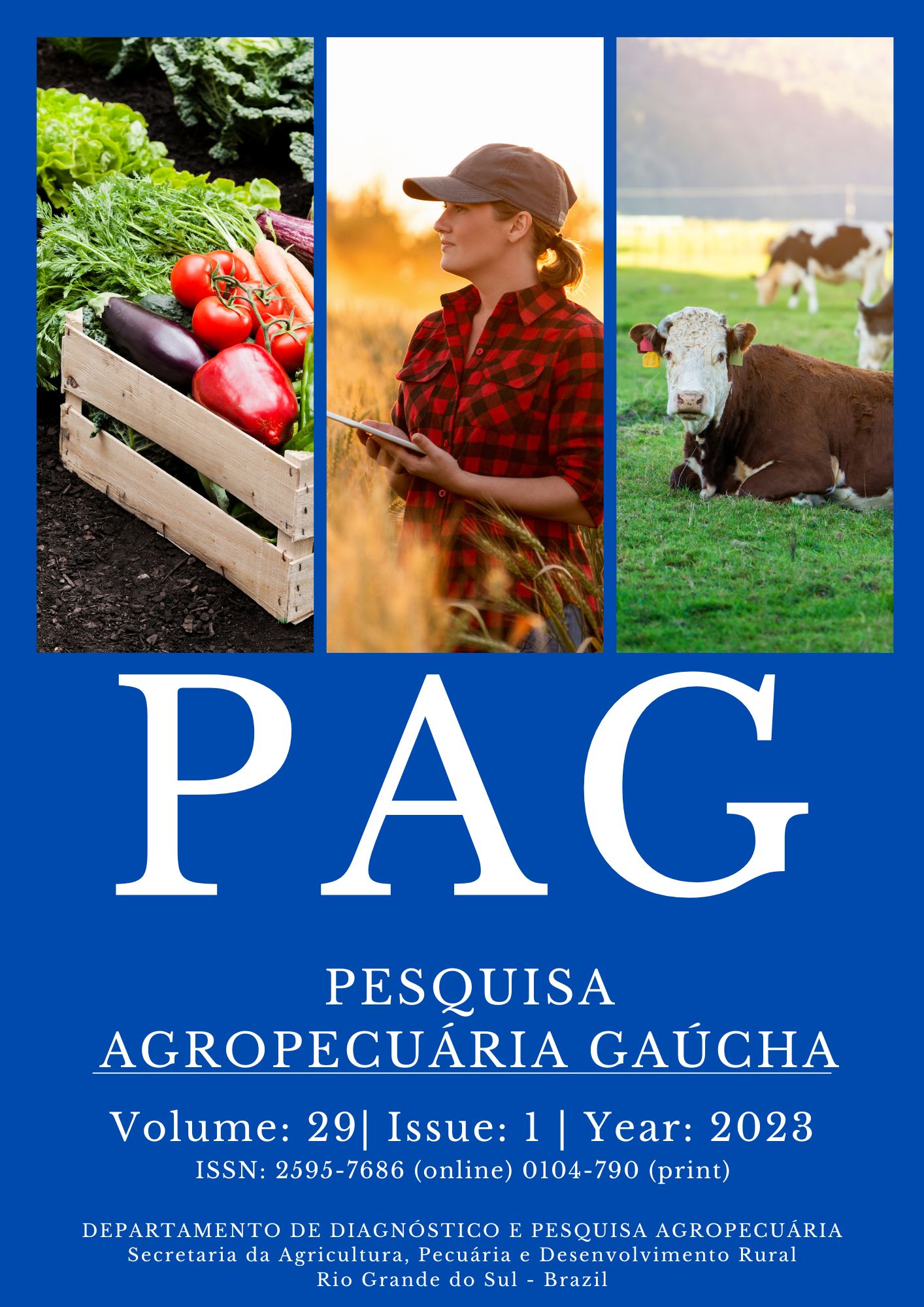Atividade inseticida do óleo essencial de capim limão e seus compostos majoritários sobre a lagarta-da-soja
Resumo
O presente trabalho teve como objetivo avaliar a atividade inseticida do óleo essencial de Cymbopogon citratus e de seus compostos majoritários (citral e mirceno) sobre Anticarsia gemmatalis. O óleo essencial, citral, mirceno e uma mistura de citral e mirceno foram testados nas concentrações de 0,1, 0,3, 0,5, 0,7 e 0,9 % v/v, mais dois controles negativos (água destilada e Tween-80® 0,5 % v/v) e um controle positivo (novaluron 0,075 % m/v). A mortalidade dos insetos foi avaliada em 24, 48, 72 e 96 h. De acordo com os resultados, o óleo essencial de C. citratus e a mistura de citral-mirceno a 0,9 % v/v foram eficazes no controle de A. gemmatalis, com mortalidade de 96 % e 88 %, respectivamente, nas primeiras 24 h. Nesta concentração, o citral causou 100 % de mortalidade após 72 h, enquanto o mirceno não teve efeito nas lagartas mesmo após 96 h de exposição. Assim, o óleo essencial de C. citratus pode ser uma opção potencial para o controle alternativo de A. gemmatalis.
Downloads
Referências
ANDRADE-OCHOA, S. et al. Oviposition deterrent and larvicidal activity of seven essential oils and their major components against Culex quinquefasciatus Say (Diptera: Culicidae): Synergism-antagonism effects. Insects, v. 9, n. 1, 25, 2018. https://doi.org/10.3390/insects9010025.
ANVISA. Agência Nacional de Vigilância Sanitária. Farmacopéia Brasileira. 5th ed. Brasília: Agência Nacional de Vigilância Sanitária, 2010.
ASADI, M. et al. Effects of plant essential oils on the changes of digestive enzymes in the ectoparasitoid, Habrobracon hebetor Say, with description of its digestive tube. Arthropod-Plant Interactions, v. 15, p. 929–935, 2021.https://doi.org/10.1007/s11829-021-09860-2.
AVOSEH, O. et al. Cymbopogon species, ethnopharmacology, phytochemistry and the pharmacological importance. Molecules, v. 20, n. 5, p. 7438-7453, 2015. https://doi.org/10.3390/molecules20057438.
BEDINI, S. et al. Not just for beer: evaluation of spent hops (Humulus lupulus L.) as a source of eco-friendly repellents for insect pests of stored foods. Journal of Pest Science, v. 88, p. 583-592, 2015. https://doi.org/10.1007/s10340-015-0647-1.
BRASIL. Ministério da Agricultura, Pecuária e Abastecimento. Sistema de agrotóxicos fitossanitários. Brasília: Ministério da Agricultura, Pecuária e Abastecimento, 2021. Available from: https://www.gov.br/agricultura/pt-br/acesso-a-informacao/acoes-e-programas/cartas-de-servico/defesa-agropecuaria-agrotoxicos/agrotoxicos-registrados-no-agrofit. Accessed: Jan. 18, 2022.
DENT, D.; BINKS, R. H. Insect Pest Management. 3rd ed. Oxfordshire: CAB International, 2020. https://doi.org/10.1079/9781789241051.000.
EKPENYONG, C. E.; AKPAN, E.; NYOH, A. Ethnopharmacology, phytochemistry, and biological activities of Cymbopogon citratus (DC.) Stapf extracts. Chinese Journal of Natural Medicines, v. 13, n. 5, p. 321-337, 2015. https://doi.org/10.1016/S1875-5364(15)30023-6.
ENAN, E. Insecticidal activity of essential oils: octopaminergic sites of action. Comparative Biochemistry and Physiology - Part C: Toxicology & Pharmacology, v. 130, n. 3, p. 325-337, 2001. https://doi.org/10.1016/S1532-0456(01)00255-1.
FOGNÉ, D. S. et al. Susceptibility of MED-Q1 and MED-Q3 biotypes of Bemisia tabaci (Hemiptera: Aleyrodidae) populations to essential and seed oils. Journal of Economic Entomology, v. 110, n. 3, p. 1031-1038, 2017. https://doi.org/10.1093/jee/tox100.
GAJGER, I. T.; DAR, S. A. Plant allelochemicals as sources of insecticides. Insects, v. 12, n. 3, 189, 2021. https://doi.org/10.3390/insects12030189.
GARCÍA-DÍEZ, J. et al. Synergistic activity of essential oils from herbs and spices used on meat products against food borne pathogens. Natural Product Communications, v. 12, n. 2, p. 281-286, 2017. https://doi.org/10.1177/1934578X1701200236.
GREENE, G. L.; LEPPLA, N. C.; DICKERSON, W. A. Velvet caterpillar: a rearing procedure and artificial medium. Journal of Economic Entomology, v. 69, n. 4, p. 487-488, 1976. https://doi.org/10.1093/jee/69.4.487.
HAHN, R. C. et al. Atividade inseticida do óleo essencial de Cymbopogon citratus sobre Anticarsia gemmatalis. In: ENCONTRO DE JOVENS PESQUISADORES E MOSTRA ACADÊMICA DE INOVAÇÃO E TECNOLOGIA, 26., 2018, Caxias do Sul. Proceedings… Caxias do Sul: UCS, 2018. 1 p.
HSU, W. S.; YEN, J. H.; WANG, Y. S. Formulas of components of citronella oil against mosquitoes (Aedes aegypti). Journal of Environmental Science and Health: B, v. 48, n. 11, p. 1014-1019, 2013. https://doi.org/10.1080/03601234.2013.816613.
ITANKAR, P. R.; TAUQEER, M.; DALAL, J. S. Toxicological and pharmacological profiling of organically and non-organically cultivated Cymbopogon citratus. Journal of Ayurveda and Integrative Medicine, v. 10, n. 4, p. 233-240, 2019. https://doi.org/10.1016/j.jaim.2017.04.002.
JANKOWSKA, M. et al. Molecular targets for components of essential oils in the insect nervous system - a review. Molecules, v. 23, n. 1, 34, 2018. https://doi.org/10.3390/molecules23010034.
KHORRAM, M. S. et al. The toxicity of selected monoterpene hydrocarbons as singles compounds and mixtures against different developmental stages of Colorado Potato Beetle, Leptinotarsa decemlineata Say (Coleoptera: Chrysomelidae). Journal of Entomology, v. 8, n. 5, p. 404-416, 2011. https://doi.org/10.3923/je.2011.404.416.
KIMUTAI, A. et al. Repellent effects of the essential oils of Cymbopogon citratus and Tagetes minuta on the sandfly, Phlebotomus duboscqi. BMC Research Notes, v. 10, n. 98, 2017. https://doi.org/10.1186/s13104-017-2396-0.
LOUIS-CLÉMENT, O. E. et al. Larvicidal and ovicidal properties against Anopheles gambiae, antioxidant and antibacterial activities of the combination of essential oils Eucalyptus citriodora, Cymbopogon giganteus and Cymbopogon nardus from Gabon. Journal of Multidisciplinary Engineering Science and Technology, v. 4, n. 8, p. 7887-7894, 2017.
MENEZES, E. L. A. Inseticidas botânicos: seus princípios ativos, modo de ação e uso agrícola. Seropédica: Embrapa Agrobiologia, 2005. 53 p.
MOUSTAFA, M. A. M. et al. Insecticidal activity of lemongrass essential oil as an eco-friendly agent against the black cutworm Agrotis ipsilon (Lepidoptera: Noctuidae). Insects, v. 12, n. 8, 737, 2021. https://doi.org/10.3390/insects12080737.
OLADEJI, O. S. et al. Phytochemistry and pharmacological activities of Cymbopogon citratus: a review. Scientific African, v. 6, e00137, 2019. https://doi.org/10.1016/j.sciaf.2019.e00137.
OLORUNNISOLA, S. K. et al. Biological properties of lemongrass: an overview. International Food Research Journal, v. 21, n. 2, p. 455-462, 2014.
PAULETTI, G. F. et al. Poejo (Cunila galioides Benth.) production in five agroecological regions of Rio Grande do Sul. Brazilian Archives of Biology and Technology, v. 63, e20190481, 2020. https://doi.org/10.1590/1678-4324-2020190481.
PAVELA, R.; BENELLI, G. Essential oils as ecofriendly biopesticides? Challenges and constraints. Trends in Plant Science, v. 21, n. 12, p. 1000–1007, 2016. https://doi.org/10.1016/j.tplants.2016.10.005.
PINTO, Z. T. et al. Chemical composition and insecticidal activity of Cymbopogon citratus essential oil from Cuba and Brazil against housefly. Revista Brasileira de Parasitologia Veterinária, v. 24, n. 1, p. 36-44, 2015. https://doi.org/10.1590/S1984-29612015006.
PLATA-RUEDA, A. et al. Insecticidal and repellent activities of Cymbopogon citratus (Poaceae) essential oil and its terpenoids (citral and geranyl acetate) against Ulomoides dermestoides. Crop Protection, v. 137, 105299, 2020. https://doi.org/10.1016/j.cropro.2020.105299.
PLATA-RUEDA, A. et al. Lemongrass essential oil and its components cause effects on survival, locomotion, ingestion, and histological changes of the midgut in Anticarsia gemmatalis caterpillars. Toxin Reviews, v. 41, n. 1, p. 208-217, 2021. https://doi.org/10.1080/15569543.2020.1861468.
PRAÇA, L. B.; MORAES, S.; MONNERAT, R. G. Anticarsia gemmatalis Hübner, 1818 (Lepidoptera: Noctuidae): Biologia, amostragem e métodos de controle. Brasília: Embrapa Recursos Genéticos e Biotecnologia, 2006. 17 p.
REBELO, R. A. et al. Essential oils from leaves of Vernonanthura montevidensis (Spreng.) H. Rob.: chemical profile and antimollicute potential. Natural Product Research, v. 36, n. 9, p. 2393-2398, 2022. https://doi.org/10.1080/14786419.2020.1831491.
REGNAULT-ROGER, C. Essential oils in insect control. In: Ramawat, K. G.; Mérillom, J. M. (Eds.) Natural products: phytochemistry, botany, and metabolism of alkaloids, phenolics, and terpenes. Berlin: Springer-Verlag Berlin Heidelberg, 2013. p. 4087-4107.
SCALERANDI, E. et al. Understanding synergistic toxicity of terpenes as insecticides: contribution of metabolic detoxification in Musca domestica. Frontiers in Plant Science, v. 9, 1579, 2018. https://doi.org/10.3389/fpls.2018.01579.
SESSOU, P. et al. Bioefficacy of Cymbopogon citratus essential oil against food borne pathogens in culture medium and in traditional cheese wagashi produced in Benin. International Research Journal of Microbiology, v. 3, n. 12, p. 406-415, 2012.
SHAHRIARI, M. et al. Bio-efficacy and physiological effects of Eucalyptus globulus and Allium sativum essential oils against Ephestia kuehniella Zeller (Lepidoptera: Pyralidae). Toxin Reviews, v. 39, n.4, p. 422-433, 2020. https://doi.org/10.1080/15569543.2018.1554588.
SHAH, G. et al. Scientific basis for the therapeutic use of Cymbopogon citratus, stapf (Lemon grass). Journal of Advanced Pharmaceutical Technology Research, v. 2, n. 1, p. 3-8, 2011. https://doi.org/10.4103/2231-4040.79796.
SHAH, T. et al. Impact of nanomaterials on plant economic yield and next generation. In: Ghorbanpour. M.; Wani, S. H. (Eds.). Advances in phytonanotecnology: from synthesis to application. London: Academic Press, 2019. p. 203-214.
SILVESTRE, W. P. et al. Fractionation of rosemary (Rosmarinus officinalis L.) essential oil using vacuum fractional distillation. Journal of Food Science and Technology, v. 56, p. 5422-5434, 2019. https://doi.org/10.1007/s13197-019-04013-z.
SILVESTRE, W. P. et al. Insecticidal activity of Callistemon speciosus essential oil on Anticarsia gemmatalis and Spodoptera frugiperda. International Journal of Tropical Insect Science, v. 42, p. 1307-1314, 2021. https://doi.org/10.1007/s42690-021-00648-8.
STOLERU, E.; BREBU, M. Stabilization techniques of essential oils by incorporation into biodegradable polymeric materials for food packaging. Molecules, v. 26, n. 20, 6307, 2021. https://doi.org/10.3390/molecules26206307.
SUDO, M. et al. Optimal management strategy of insecticide resistance under various insect life histories: heterogeneous timing of selection and interpatch dispersal. Evolutionary Applications, v. 11, n.2, p. 271-283, 2017. https://doi.org/10.1111/eva.12550.
SUN, J. et al. Investigation of pesticidal effects of Peucedanum terebinthinaceum essential oil on three stored-product pests. Records of Natural Products, v. 14, n. 3, p. 177-189, 2020. https://doi.org/10.25135/rnp.149.19.05.1287.
TOSI, S.; NIEH, J. C. Lethal and sublethal synergistic effects of a new systemic pesticide, flupyradifurone (Sivanto®), on honeybees. Proceedings of the Royal Society B, v. 286, n. 1900, 20190433, 2019. https://doi.org/10.1098/rspb.2019.0433.
VICENÇO, C. B. et al. Bioactivity of Schinus molle L. and Schinus terebinthifolia Raddi. Essential Oils on Anticarsia gemmatalis (Hübner 1818). Brazilian Archives of Biology and Technology, v. 63, e20200111, 2020. https://doi.org/10.1590/1678-4324-2020200111.
VICENÇO, C. B. et al. Insecticidal activity of Lavandula dentata L. essential oil on Anticarsia gemmatalis (Hübner, 1818). Brazilian Archives of Biology and Technology, v. 64, e21210327, 2021. https://doi.org/10.1590/1678-4324-2021210327.
VIEGAS JÚNIOR, C. Terpenos com atividade inseticida: uma alternativa para o controle químico de insetos. Química Nova, v. 26, n. 3, p. 390-400, 2003. https://doi.org/10.1590/S0100-40422003000300017.
WAR, A. R. et al. Mechanisms of plant defense against insect herbivores. Plant Signaling & Behavior, v. 7, n. 10, p. 1306-1320, 2012. https://doi.org/10.4161/psb.21663.
ZHU, F. et al. Insecticide resistance and management strategies in urban ecosystems. Insects, v. 7, n. 1, 2, 2016. https://doi.org/10.3390/insects7010002.
Copyright (c) 2023 Pesquisa Agropecuária Gaúcha

This work is licensed under a Creative Commons Attribution-NonCommercial-ShareAlike 4.0 International License.
Os autores declaram que o trabalho não foi publicado anteriormente, nem enviado simultaneamente para publicação em outro periódico e que concordam com a submissão, conteúdo e transferência dos direitos de publicação do artigo em questão para o periódico científico Pesquisa Agropecuária Gaúcha - PAG. Os autores assumem total responsabilidade pela originalidade do artigo, podendo incidir sobre os mesmos, eventuais encargos decorrentes de reivindicação, por parte de terceiros, em relação à autoria do artigo.
A reprodução total dos artigos da Revista em outros meios de comunicação eletrônicos de uso livre é permitida de acordo com a licença Creative Commons Atribuição-NãoComercial-CompartilhaIgual 4.0 Internacional.



















